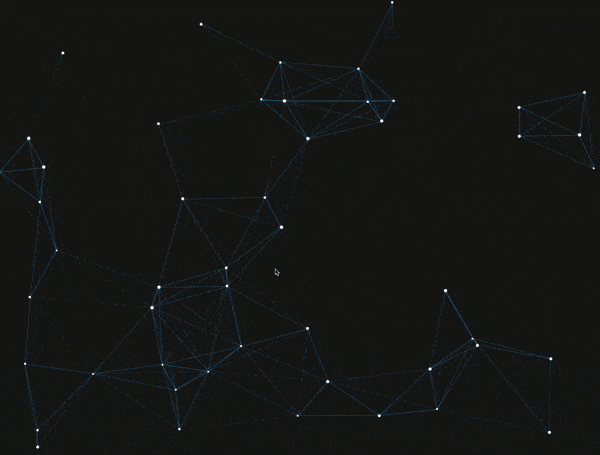Particle Background Effect with HTML Canvas
Particle Background Effect with HTML Canvas
By Steve Jonk
2 min read
Create a dynamic animated particle background using the HTML5 Canvas API

- Authors

- Name
- Steve Jonk
I always wanted to create a subtle, animated background effect, without relying on any external libraries. This React component uses only the HTML5 Canvas API to render a particle system with animated lines, making it lightweight, customizable, and easy to integrate into any modern UI.
What it looks like
Before I dive into the code, here’s a quick preview of what the effect looks like in action. Or you can view my personal site to see it in your browser: stevejonk.com.

The Component
The core of the effect is a React component (Background.tsx) that draws and animates particles on a <canvas>. Each particle moves independently, and lines are drawn between particles that are close to each other.
Key features:
- Responsive: The canvas resizes with the window.
- Customizable: Particle count, speed, color, and link radius are easy to tweak.
- Efficient: Uses
requestAnimationFramefor smooth animation.
How it Works
- Particles: Each particle has a position, speed, direction, and color. They bounce off the canvas edges.
- Lines: When two particles are within a certain distance, a line is drawn between them with opacity based on distance.
- Animation Loop: The component uses
requestAnimationFrameto update and redraw the scene.
Code Walkthrough
The main logic lives inside a useEffect hook, which sets up the canvas, particles, animation loop, and handles cleanup.
Canvas Setup
A ref is used to access the canvas, and its size is set to match the window. The canvas resizes responsively:
const canvasRef = (useRef < HTMLCanvasElement) | (null > null)
const resizeReset = () => {
w = canvas.width = window.innerWidth
h = canvas.height = window.innerHeight
}
window.addEventListener('resize', resizeReset)
Particle Class
Each particle is an instance of a class with position, speed, direction, and color. The update method moves the particle and bounces it off the edges:
class Particle {
// ...
update() {
this.border()
this.x += this.vector.x
this.y += this.vector.y
}
border() {
if (this.x >= w || this.x <= 0) this.vector.x *= -1
if (this.y >= h || this.y <= 0) this.vector.y *= -1
if (this.x >= w) this.x = w
if (this.y >= h) this.y = h
if (this.x < 0) this.x = 0
if (this.y < 0) this.y = 0
}
}
Initialization
Particles are initialized with random positions and speeds. The amount and link radius scale with the window size:
const initializeParticles = () => {
options.particleAmount = (w + h) / 50
options.linkRadius = w / 10 + h / 5
particles = []
for (let i = 0; i < options.particleAmount; i++) {
particles.push(new Particle())
}
}
Drawing and Animation
Each frame, the canvas is cleared, particles are updated and drawn, and lines are drawn between close particles with opacity based on distance:
const drawParticles = () => {
particles.forEach((p) => {
p.update()
p.draw()
})
}
const linkPoints = (point, hubs) => {
hubs.forEach((hub) => {
const distance = checkDistance(point.x, point.y, hub.x, hub.y)
const opacity = 1 - distance / options.linkRadius
if (opacity > 0) {
ctx.strokeStyle = `rgba(${rgb[0]}, ${rgb[1]}, ${rgb[2]}, ${opacity})`
ctx.beginPath()
ctx.moveTo(point.x, point.y)
ctx.lineTo(hub.x, hub.y)
ctx.stroke()
}
})
}
const loop = () => {
ctx.clearRect(0, 0, w, h)
drawLines()
drawParticles()
loopId = requestAnimationFrame(loop)
}
Source Code
See the full code in components/Background.tsx in this repo.
This effect is a great way to add a modern, interactive touch to your site’s background without heavy dependencies.